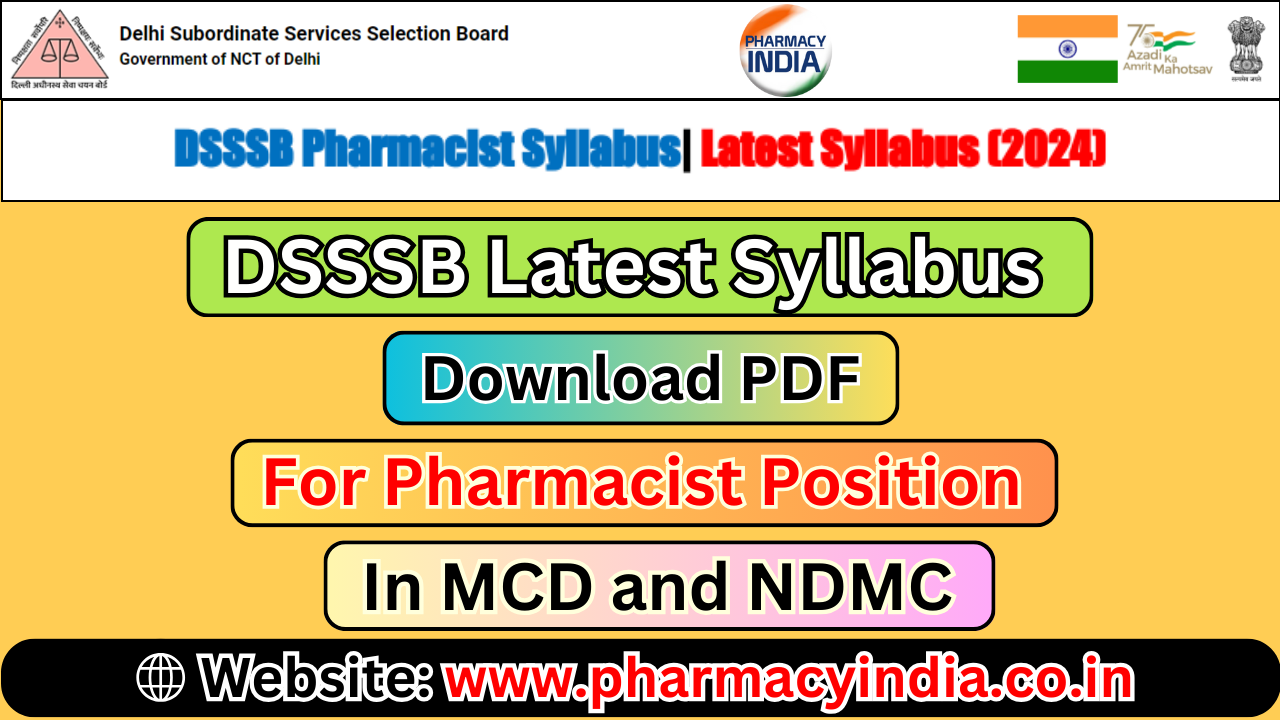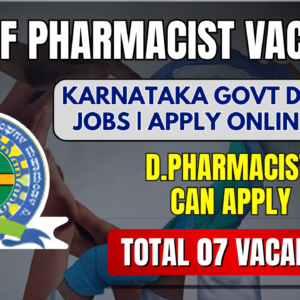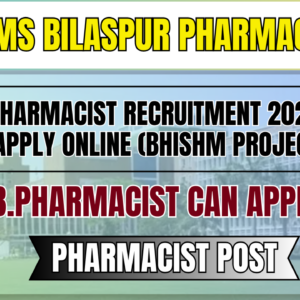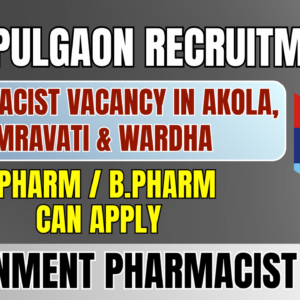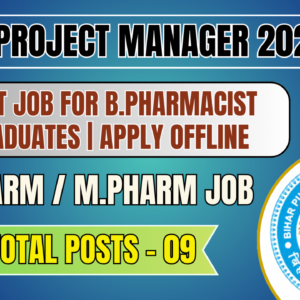DSSSB Latest Syllabus for Pharmacist Positions in MCD & NDMC
The Delhi Subordinate Services Selection Board (DSSSB) has recently unveiled the latest syllabus for the positions of Pharmacist (Dispenser) in the Municipal Corporation of Delhi (MCD) and Pharmacist (Allopathic) in the New Delhi Municipal Council (NDMC). This comprehensive syllabus is designed to equip aspiring pharmacists with the necessary knowledge and skills required to excel in their roles. Below is a detailed overview of the syllabus, organized by key subjects and topics.
PHARMACEUTICS
History of Pharmacy
- Evolution of Pharmacy education, industry, and practice in India.
- Role of various professional associations.
Pharmacopoeia Overview
- Introduction to Indian Pharmacopoeia (IP), British Pharmacopoeia (BP), United States Pharmacopoeia (USP), National Formulary (NF), and Extra Pharmacopoeia.
- Salient features of the Indian Pharmacopoeia.
Packaging Materials
- Types and selection criteria.
- Advantages and disadvantages of glass, plastic, metal, and rubber packaging.
Pharmaceutical Aids
- Organoleptic Agents: Colouring, flavouring, and sweetening.
- Preservatives: Definitions, types with examples, and uses.
Unit Operations
- Size Reduction: Hammer mill and ball mill.
- Size Separation: Classification of powders, cyclone separator, sieves, and standards.
- Mixing: Double cone blender, turbine mixer, triple roller mill, and Silverson mixer.
- Filtration: Theory, membrane filters, and sintered glass filters.
- Drying: Fluidized bed dryer and freeze drying process.
- Extraction: Definitions, classifications, methods, and applications.
Dosage Forms
- Tablets: Coated, uncoated, sustained-release, extended-release, fast-dissolving, multi-layered.
- Capsules: Hard and soft gelatin capsules.
- Liquid Oral Preparations: Solutions, syrups, elixirs, emulsions, suspensions, dry powders for reconstitution.
- Topical Preparations: Ointments, creams, pastes, gels, liniments, lotions, suppositories, and pessaries.
- Other Preparations: Nasal, ear preparations, powders, and granules.
- Sterile Formulations: Injectables, eye drops, and eye ointments.
- Immunological Products: Sera, vaccines, toxoids, and manufacturing methods.
Pharmaceutical Manufacturing
- Structure, layout, sections, and activities of pharmaceutical manufacturing plants.
- Quality Control and Assurance: Definitions, concepts, Current Good Manufacturing Practices (CGMP), calibration, and validation.
- Novel Drug Delivery Systems: Classification, examples, advantages, and challenges.
PHARMACEUTICAL CHEMISTRY
Introduction to Pharmaceutical Chemistry
- Scope and objectives.
- Sources and types of errors: Accuracy, precision, significant figures.
- Impurities in Pharmaceuticals: Sources, effects, limit tests for various substances.
Analytical Techniques
- Volumetric Analysis: Fundamentals, types of titrations.
- Gravimetric Analysis: Principles and methods.
Inorganic Pharmaceuticals
- Formulations, market preparations, storage conditions, and uses of various agents.
- Haematinics: Ferrous sulphate, ferrous fumarate, etc.
- Gastrointestinal Agents: Antacids, acidifying agents, protectives, cathartics.
- Topical Agents: Silver nitrate, chlorhexidine gluconate, etc.
- Dental Products: Calcium carbonate, sodium fluoride, etc.
- Medicinal Gases: Carbon dioxide, nitrous oxide, oxygen.
Organic Chemistry
- Nomenclature of organic compounds, especially heterocyclic compounds.
- Medicinal Compounds: Classification, chemical names, structures, uses, stability, storage, formulations, and brand names.
- CNS Acting Drugs: Anesthetics, sedatives, antipsychotics, anticonvulsants, antidepressants.
- Autonomic Nervous System Drugs: Sympathomimetics, adrenergic antagonists, cholinergic drugs.
- Cardiovascular System Drugs: Beta-blockers, anti-arrhythmics, antihypertensives, diuretics.
- Anti-Infective Agents: Antifungals, antibiotics, antivirals, antimalarials, etc.
- Pharmacognosy: Definition, classification, quality control of crude drugs, therapeutic activities.
PHARMACOGNOSY
Introduction to Pharmacognosy
- Definition, history, scope.
- Classification of drugs: Alphabetical, taxonomical, morphological, pharmacological, chemical, chemo-taxonomical.
Quality Control of Crude Drugs
- Methods of adulteration.
- Evaluation of crude drugs.
Active Constituents
- Alkaloids, Terpenoids, Glycosides, Volatile Oils, Tannins, Resins.
- Biological sources, chemical constituents, therapeutic efficacy.
Medicinal Plants and Their Uses
- Laxatives: Aloe, castor oil, etc.
- Cardiotonic Agents: Digitalis, arjuna.
- Carminatives and G.I. Regulators: Coriander, fennel, ginger, etc.
- Astringents, Antidiabetics, Diuretics, Antiseptics, Antimalarials, Vitamins, Enzymes, Pharmaceutical Aids.
Traditional Systems of Medicine
- Principles of Ayurveda, Siddha, Unani, Homeopathy.
- Preparation of Ayurvedic formulations.
- Role of medicinal and aromatic plants in the economy.
HUMAN ANATOMY AND PHYSIOLOGY
Scope and Definitions
- Various terminologies.
- Structure of the cell and its components.
Tissue Types
- Epithelial, Connective, Muscular, Nervous tissues: Sub-types and characteristics.
Major Systems
- Osseous System: Bone structure, joints, disorders.
- Hematopoietic System: Blood composition, hemopoiesis, blood groups.
- Lymphatic System: Lymph composition, spleen, lymph nodes.
- Cardiovascular System: Heart anatomy, blood vessels, circulation, ECG basics.
- Respiratory System: Anatomy, respiration mechanisms, volumes, capacities.
- Digestive System: GIT anatomy, accessory glands, digestion, absorption.
- Muscular System: Skeletal muscles, histology, contraction, disorders.
- Nervous System: CNS and ANS anatomy, cranial nerves, reflexes.
- Sense Organs: Eye, ear, skin, tongue, nose.
- Urinary System: Anatomy, urine formation, renal tests.
- Endocrine System: Hormones, glands, functions.
- Reproductive System: Anatomy, physiology of menstruation, spermatogenesis, oogenesis, pregnancy.
SOCIAL PHARMACY
Introduction to Social Pharmacy
- Definition, scope, role in public health.
- Health Concepts: WHO definitions, health indicators, National Health Policy.
- Public and Private Health Systems: National Health Mission, Sustainable Development Goals.
Preventive Healthcare
- Role of pharmacists in demography, family planning, maternal and child health.
- Vaccination, immunization strategies.
Environmental Health
- Impact of environment on health: Pollution, safe drinking water, occupational illnesses.
Psychosocial Pharmacy
- Drugs of misuse: Psychotropics, narcotics, alcohol, tobacco.
- Social impacts: Health, productivity, suicidal behaviors.
Nutrition and Health
- Basics of nutrition: Macronutrients, micronutrients, water, fibers.
- Malnutrition, diet-related diseases, food safety, drug-food interactions.
Microbiology and Epidemiology
- Common microorganisms, epidemiological terms.
- Role of pharmacists in preventing communicable diseases.
Pharma Coeconomics
- Introduction, terminologies, importance.
PHARMACOLOGY
General Pharmacology
- Introduction, scope.
- Drug administration routes, absorption, bioavailability, distribution, biotransformation, excretion.
- Mechanisms of drug action.
Pharmacological Actions by System
- Peripheral Nervous System: Cholinergic, adrenergic drugs, neuromuscular blockers, NSAIDs.
- Eye: Miotics, mydriatics, glaucoma drugs.
- Central Nervous System: Anesthetics, hypnotics, anticonvulsants, antidepressants, antipsychotics, opioids.
- Cardiovascular System: Antihypertensives, anti-anginals, anti-arrhythmics, heart failure drugs.
- Blood and Blood Forming Organs: Hematinics, anticoagulants, antiplatelets, thrombolytics.
- Respiratory System: Bronchodilators, expectorants, anti-tussives, mucolytics.
- Gastrointestinal Tract: Anti-ulcer drugs, anti-emetics, laxatives, anti-diarrheals.
- Kidney: Diuretics, anti-diuretics.
- Hormones and Antagonists: Thyroid hormones, insulin, estrogen, progesterone, corticosteroids.
- Chemotherapeutic Agents: Antibiotics, anti-tubercular, antifungal, antiviral, antimalarial, anti-neoplastic agents.
- Biologicals: Types, indications.
COMMUNITY PHARMACY AND MANAGEMENT
Community Pharmacy Practice
- Definition, history, development in India and internationally.
- Professional responsibilities, Good Pharmacy Practice (GPP), Standard Operating Procedures (SOPs).
Prescription Handling
- Parts of prescriptions, legality, labeling, dispensing process.
- Strategies to minimize dispensing errors.
Communication Skills
- Verbal Communication: One-to-one, over the telephone.
- Written Communication: Documentation, prescription handling.
- Body Language: Non-verbal cues.
- Patient Interaction: Interview techniques, counseling.
Patient Counseling
- Definition, benefits.
- Stages: Introduction, content, process, closing.
- Overcoming barriers.
- Counseling for chronic diseases: Hypertension, Diabetes, Asthma, etc.
- Patient Package Inserts (PPI) and Information Leaflets.
Medication Adherence
- Definitions, factors influencing non-adherence.
- Strategies to improve adherence.
Health Screening Services
- Introduction, scope, importance in community pharmacy.
- Early detection and referral processes.
Over The Counter (OTC) Medications
- Definitions, roles of pharmacists.
- Counseling for OTC products, safe self-medication practices.
- Managing minor ailments: Pain, cough, cold, etc.
Community Pharmacy Management
- Legal requirements, site selection, pharmacy design.
- Vendor selection, procurement, inventory control.
- Financial planning, accountancy.
- Pharmacy operation software, Customer Relationship Management (CRM).
- Audits, SOPs, digital health integration.
BIOCHEMISTRY & CLINICAL PATHOLOGY
Introduction to Biochemistry
- Scope in pharmacy, cell biochemical organization.
Biomolecules
- Carbohydrates: Types, structures, biological roles.
- Proteins: Classification, amino acids, structures, malnutrition diseases.
- Lipids: Classification, triglycerides, fatty acids, cholesterol, lipoproteins.
- Nucleic Acids: Structure, components, functions.
- Enzymes: Properties, classifications, mechanisms, therapeutic importance.
- Vitamins: Classification, functions, deficiency diseases.
- Metabolism: Carbohydrate, lipid, amino acid metabolism; biological oxidation.
- Minerals: Types, functions, deficiency diseases.
- Water and Electrolytes: Distribution, functions, balance, dehydration therapy.
- Biotechnology: Introduction.
- Organ Function Tests: Kidney, liver, lipid profiles.
- Pathology of Blood and Urine: Cell roles, abnormal constituents.
PHARMACOTHERAPEUTICS
Introduction
- Scope, rational use of medicines, Evidence-Based Medicine.
- Essential Medicines List, Standard Treatment Guidelines (STGs).
System-Based Management
- Cardiovascular: Hypertension, angina, hyperlipidemia, heart failure.
- Respiratory: Asthma, COPD.
- Endocrine: Diabetes, thyroid disorders.
- CNS: Epilepsy, Parkinson’s, Alzheimer’s, stroke, migraine.
- Gastrointestinal: GERD, peptic ulcer, liver diseases, IBD.
- Hematological: Anemias.
- Infectious Diseases: TB, pneumonia, UTIs, hepatitis, HIV/AIDS, malaria.
- Musculoskeletal: Arthritis, osteoarthritis.
- Dermatology: Psoriasis, scabies, eczema.
- Psychiatric: Depression, anxiety, psychosis.
- Ophthalmology: Conjunctivitis, glaucoma.
- Antimicrobial Resistance.
- Women’s Health: PCOS, dysmenorrhea, PMS.
HOSPITAL AND CLINICAL PHARMACY
Hospital Pharmacy
- Definition, scope, structure.
- Professional responsibilities, qualifications, job specifications.
- Good Pharmacy Practice (GPP), Hospital Pharmacy Standards (FIP-Basel, AHSP).
- NAQS guidelines, NABH accreditation.
Hospital Committees
- Pharmacy and Therapeutics Committee: Objectives, composition, functions.
- Hospital Formulary: Development, usage.
- Infection Control Committee: Role in antimicrobial resistance prevention.
Supply Chain and Inventory Control
- Drug lists: High-risk, emergency, Schedule H1, NDPS drugs.
- Drug purchasing procedures, inventory control techniques.
- Central Drug Store management: Storage, cold chain maintenance, FEFO/FIFO methods.
- Drug disposal: Narcotics, cytotoxic drugs.
Drug Distribution
- Methods: Individual prescription, floor stock, unit dose, drug basket.
- Distribution to specialized wards: ICU, NICU, Emergency.
- Automated dispensing systems, narcotic storage.
- Compounding: Bulk, IV admixtures, parenteral nutrition, radiopharmaceuticals.
- Use of computers: Electronic health records, pharmacy software.
Clinical Pharmacy
- Definition, scope, development.
- Daily activities: Ward rounds, treatment chart reviews, ADR monitoring, drug information, patient counseling.
- Interprofessional collaboration, pharmaceutical care.
- Medication Therapy Management, Home Medication Review.
- Clinical laboratory tests: Significance, interpretation.
- Poisoning management, Drug and Poison Information Centres.
- Pharmacovigilance: Aims, scope.
- Medication errors: Types, consequences, prevention.
- Drug interactions: Definitions, types, clinical significance.
PHARMACY LAW AND ETHICS
General Principles of Law
- History, various Acts related to drugs and pharmacy.
Pharmacy Act-1948 and Rules
- Objectives, definitions.
- Pharmacy Council of India: Constitution, functions.
- Education regulations, state pharmacy councils.
- Registration of pharmacists, offenses, penalties.
Pharmacy Practice Regulations 2015
- Compliance with laws and standards.
Drugs and Cosmetics Act 1940 and Rules 1945
- Objectives, definitions, schedules.
- Import regulations: Prohibited classes, licensing requirements.
The DSSSB’s latest syllabus for Pharmacist positions in MCD and NDMC is extensive and covers a wide range of subjects essential for effective pharmacy practice. Candidates are advised to thoroughly study each section, utilize the provided links for detailed information, and prepare systematically to excel in the examinations.
For more detailed information, refer to the official links:
Good luck to all aspirants!
MORE : UPUMS Pharmacist Recruitment 2024 Exam Date Out, Check Admit Card & Eligibility
<<<<<<<<<<<<JOIN US>>>>>>>>>>>>>>>>
| Subscribe our PHARMACY INDIA YouTube Channel for more Pharma Updates | Click Here |
| Follow us on Instagram | Click Here |
| Download PHARMACY INDIA MOBILE APP from Google Play Store | Click Here |
| Follow us on LinkedIn | Click Here |


